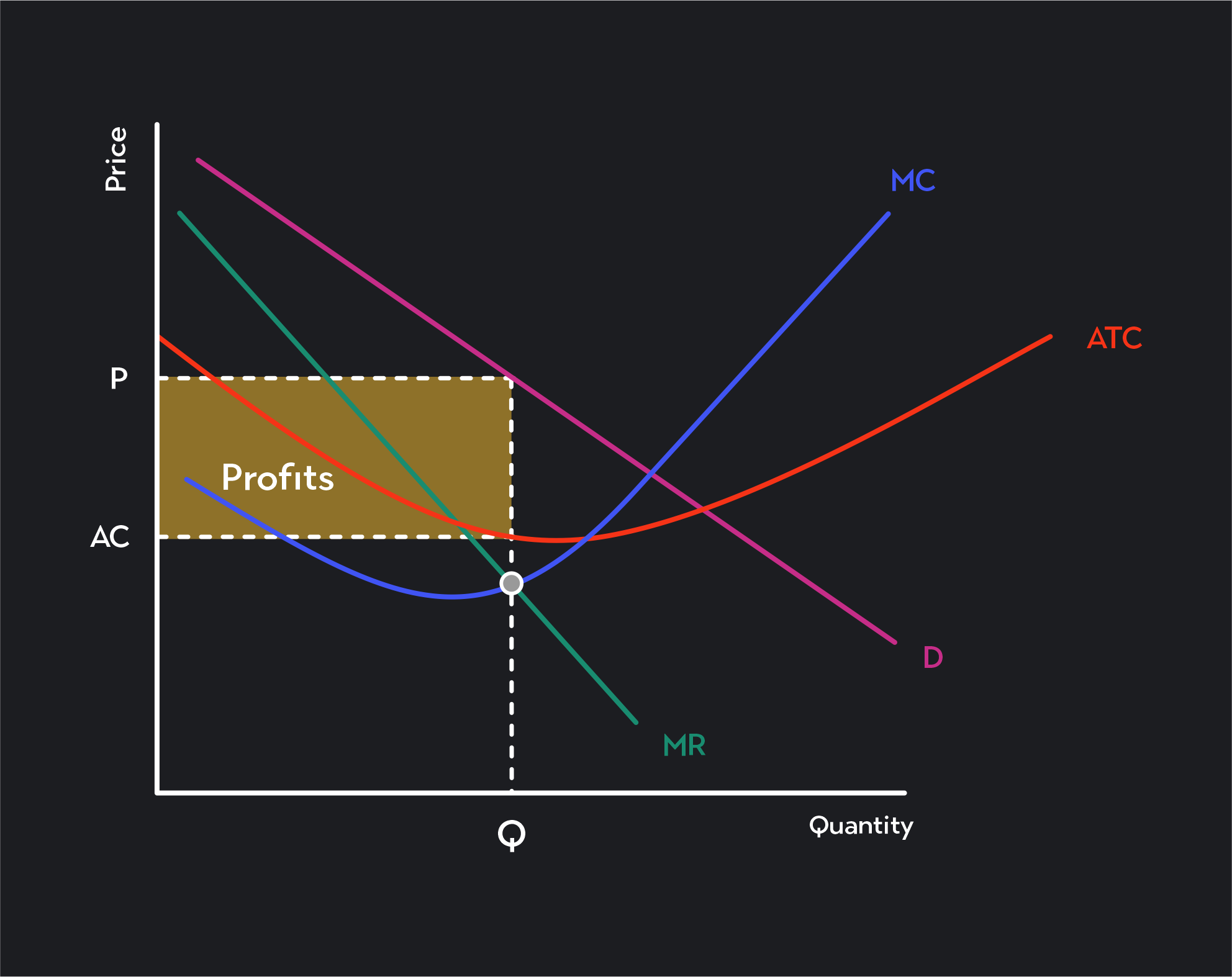In This Article
What Is a Monopoly?
Types of Monopoly
Monopoly Market Key Characteristics
Modeling a Monopolist’s Profit-Maximizing Price and Quantity
Market Structures Related to Monopoly
Pros and Cons of Monopoly Markets
Notable Monopoly Examples
What Is a Monopoly?
In economics, a monopoly is a market with one seller and many buyers.
As the sole seller in the market, a monopolist has the power to set prices and earn extraordinary profits at the expense of consumers.
Types of Monopoly
Three main types of monopolies exist.
1. Natural Monopolies
A natural monopoly is a monopoly that exists either because the first seller to the market controls a limited key resource or because of significant economies of scale and other types of naturally occurring high barriers to entry. A natural monopoly will form in markets if a single firm can serve customers at a lower cost of production than multiple firms trying to do the same.
2. Legal Monopolies
A legal monopoly is a monopoly that exists because of laws and regulations restrict competition.
Monopolists whose products are protected by intellectual property rights, such as trademarks, patents, and copyrights are good examples of legal monopolies. Legal monopolies can also arise if the costs of complying with government regulations are high. These high regulatory costs create a barrier to entry, which makes it difficult for newer, smaller firms to compete.
3. Public Monopolies
A public monopoly is a monopoly run or protected by the government. Government-granted monopolies exist to provide equitable access to necessary goods and services. The postal system, rail service, and utilities like gas, water, and electricity usually operate as public monopoly firms.
Monopoly Market Key Characteristics
Monopoly markets have the following key characteristics:
Only one firm or one dominant seller is in the market
When economists model monopolies, they assume a single seller exists in the market. A market with only one seller is called a pure monopoly. In practice, policymakers and regulators define monopolies as markets where a single seller dominates the market with a market share greater than 50 percent.
The seller can set prices
Unlike in perfect competition, where all sellers are price takers, monopolists can set their own prices subject to the market demand curve.
High barriers to entry exist
High barriers to entry make it difficult for new firms to join the market and compete with the monopolist. Barriers to entry can take many forms, such as high regulatory costs, laws protecting intellectual property, and high start-up costs.
No close substitutes are available
Monopolists gain market power by producing a good or service without close substitutes. By providing a unique product buyers want, monopolists are shielded from competition.
Modeling a Monopolist’s Profit-Maximizing Price and Quantity
In your economics courses, you will learn to model monopoly markets using the supply and demand framework.
In a monopoly model, profit maximization occurs at the quantity where the seller’s marginal revenue equals their marginal costs (MR=MC). You can find the equilibrium price by tracing quantity up to the demand curve and then over to the vertical price axis.
Monopolist’s Profit Maximizing Quantity is where MR=MC
Once you find the profit-maximizing price and quantity, you can calculate the monopolist’s profits. Their profits are equal to the area of the rectangle with a width equal to the profit-maximizing price minus average costs (P-AC) and a length equal to the profit-maximizing quantity (Q).
Monopolist’s Profit = Q(P-AC)
Market Structures Related to Monopoly
Three market structures closely related to monopoly are:
1. Monopolistic Competition
Monopolistic competition is a market where many sellers compete while each producing a slightly differentiated product.
2. Duopoly
A duopoly is a market where two sellers control the market.
3. Oligopoly
An oligopoly is a market where a small group of sellers dominates.
Pros and Cons of Monopoly Markets
Monopolies are a matter of considerable political and economic debate. In the real world, a single firm dominates many markets.
In the U.S., antitrust laws were established in 1890 to protect consumers and markets from harmful monopolistic behaviors. The three major antitrust laws in the U.S. are the Sherman Act of 1890, the Clayton Act of 1914, and the Federal Trade and Commission Act of 1914.
Pros of Monopoly Markets
Monopolies can produce some products more efficiently
In some cases, a monopoly can produce a good or a service at a lower overall cost than multiple firms competing in the same market.
Innovation
The prospect of earning monopoly profits motivates many businesses to develop new and innovative products that require investment in large fixed costs. Companies earning monopoly profits can choose to invest in further innovation to improve existing products or develop new ones.
Cons of Monopoly Markets
Higher prices can lead to lower output and lower overall utility
According to economists, the main disadvantage of having a monopoly is a profit-maximizing monopolist will charge a high price and produce less than would be the case in a competitive market. This restriction in output usually lowers the total amount of welfare—or surplus—produced in the market.
Predatory Behavior
A monopolist can engage in predatory behavior to protect its monopoly position. Behaviors such as predatory pricing, price fixing, and price discrimination keep new entrants from entering the market and harm consumers.
A lack of competition leads to inferior products and less innovation
Legal monopolies shielded from competition might produce inferior products and lose the incentive to innovate.
“Bad mergers”
Monopoly profits can make it attractive for companies with large market shares to merge. Although mergers can be beneficial for consumers, mergers designed to create a monopolistic market can result in inefficiencies and violate the Clayton Antitrust Act.
Notable Monopoly Examples
Standard Oil
John D. Rockefeller’s Standard Oil company was the world’s largest oil production company in the late 19th and early 20th century. In 1911, the U.S. Supreme Court deemed it an illegal monopoly. After the ruling, the company was dissolved and divided into 43 separate companies.
AT&T
The multinational telecommunications company is the largest telecom company in the world today by revenue. In 1982, the U.S. brought an antitrust case against the American Telephone & Telegraph company, saying the company had a monopoly over phone services in the U.S. and was using its market power to price services unfairly. As a result, the company was ordered to divest its local subsidiaries.
Microsoft
The U.S. and the European Union have both brought antitrust cases against Microsoft. In 2001, the U.S. government accused Microsoft of using its monopoly power and illegal practices to protect its market share in operating systems. Microsoft and the DOJ settled the case years later.
Google
In October 2020, the U.S. Department of Justice filed an antitrust case against Google, claiming the company violated the Sherman Antitrust Act by using anti-competitive practices to protect its dominance as a search engine and its dominance in the market for search advertising. This case is expected to go to trial later this year and will likely be one of the most influential antitrust cases to date.
Explore Outlier's Award-Winning For-Credit Courses
Outlier (from the co-founder of MasterClass) has brought together some of the world's best instructors, game designers, and filmmakers to create the future of online college.
Check out these related courses:








